DIY Mini Gudi | Gudi Padwa Craft for Kids
Make this Gudi Padwa Craft with your kids as you learn about this lovely festival! It also teaches us about the significance of every part of the Gudi!
Festivals are an inherent part of Indian culture, and we have a festival to celebrate a variety of occasions. From Diwalito Holi and Eid to Christmas, we have a special celebration for every month of the year!
As we enter March, it’s time to celebrate another less-known festival that’s close to my heart – Gudi Padwa!
What is Gudi Padwa?
Gudi Padwa is a spring-time festival that marks the traditional new year for Marathi and Konkani Hindus. It is celebrated in different states of India under different names. In Maharashtra, it is known as Gudi Padwa, Ugadi in Karnataka & Andhra Pradesh, and Sanvsar Padvo in Konkani.
Gudi Padwa is celebrated as the first day of the Chaitra month according to the lunisolar Hindu calendar. It falls on the first day the moon appears after a new-moon day (Amavasya). It marks the beginning of the New Year for many Hindus.
When is Gudi Padwa in 2023?
This year it falls on Wednesday, 22 March 2023.
What is the Story behind the Celebration Of Gudi Padwa?
The significance of this festival is mentioned in the Bramha Purana which is considered the most ancient text in history. It is believed that many many years ago there was a great deluge on Earth. Time had stopped and every living being and every aspect of nature was destroyed. It is said that on this day Lord Brahma started to create a New World. On Gudi Padwa, time started again and it hailed a new era of truth and justice also known as Satyug.
Hence on Gudi Padwa, Lord Bramha is worshipped.
It is also said that this was the day Lord Rama returned to Ayodhya after 14 years in exile. The day marks his coronation as the King. The “Gudi” is hoisted at the entrance of the household, in commemoration of the “Gudi” that was hoisted in Ayodhya as a victory flag for Lord Rama.
But, what do the words “Gudi Padwa” and “Ugadi” mean?
According to Hindu mythology, the term Gudi Padwa originates from two words ‘Gudi’, meaning flag or symbol of Lord Brahma, and ‘Padwa’ which refers to the first day of the phase of the moon.
“Ugadi” literally means “Aadi” or the beginning.
Who started the tradition of hoisting the “Gudi”?
It was believed that on this day, Chhatrapati Shivaji Maharaja had returned triumphant after defeating his enemies in war. The Gudi marked his victory. It is now followed in every Maharashtrian household. You’ll find most houses in Maharashtra have the flag in their entryways.
Celebrating Gudi Padwa
The main part of celebrating Gudi Padwa is obviously, the Gudi! If you visit Maharashtra during this festival, you’ll find a Gudi prominently displayed hanging out of windows.
A Gudi consists of a bright green or yellow cloth adorned with brocade tied to the tip of a long bamboo stick, to which neem leaves and sugar candy are attached. Some people also add mango leaves and a garland made with red flowers. The neem leaves represent purity while mango leaves signify a new beginning.
An inverted silver or copper pot is placed over the entire arrangement and the symbol of the swastika is drawn on it with kumkum. This Gudi is then placed in a prominent position outside the house, in a window, terrace, or a high place, in a slightly tilted position.
Family members offer prayers through pooja rituals and offer bhog to the “Gudi”. The puja is considered complete the following day when family members drink water from the pot that was kept inverted on the Gudi. It signifies warding off evil and bringing in good luck and positivity.
Today, we’ll make a mini Gudi to celebrate this auspicious festival – now you can explain the festival to your kids as you make this cute little Gudi Padwa craft!
DIY Mini Gudi – Gudi Padwa Craft For Kids

Supplies required:
- Bamboo stick or unsharpened pencil
- Silk, satin or brocade fabric
- Miniature copper/steel pot
- Mini pot or container
- Pipe cleaners
- Beads and embellishments
- Cotton
- Artificial leaves
- Playdough
- Yarn
- Geen paper
- Glue gun
- Acrylic paints
- Paintbrush
- Colored pencils
- Scissors
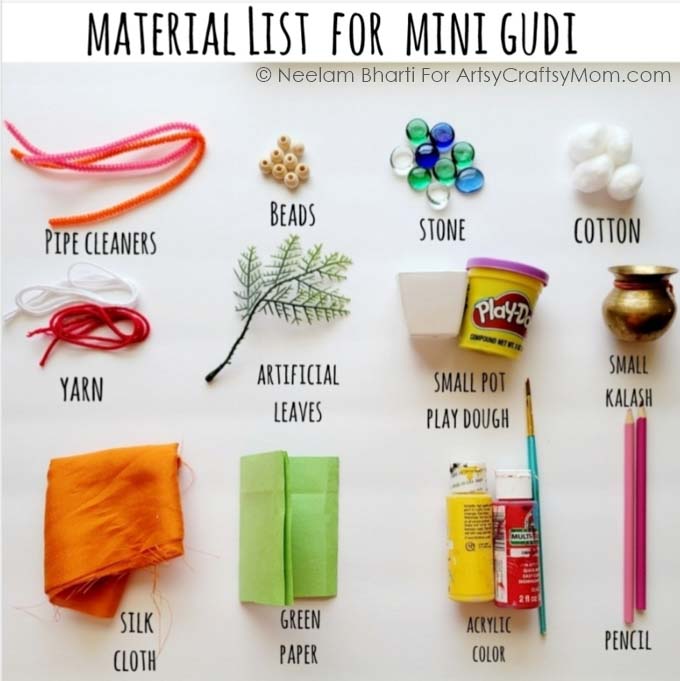
How to make the Gudi Padwa Craft for Kids:
1. Gather the pipe cleaners – we’re going to use them to make the red flower garland of our Gudi Padwa Craft. You can use red, pink or orange pipe cleaners. Cut them into little strips and then twist them into tiny little circles.

2. Take your yarn and beads. Thread the yarn through the beads and pipe cleaner ‘flowers’, alternating their positions on the garland.

3. When your garland is complete, tie up the ends and cut off any loose bits.
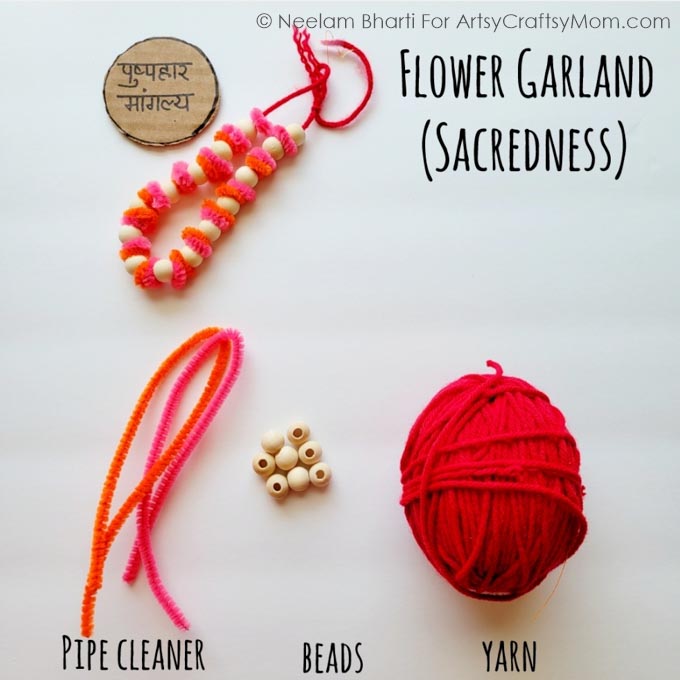
4. Time to make the sugar candy for our Gudi Padwa Craft. We are going to use the cotton to represent the candy, so place little bits of cotton wool in a straight line as shown below.

5. Place a piece of white yarn over the cotton balls and use a glue gun to secure the yarn in place.

6. Turn it over so the cotton balls are now facing you.

7. Tie up the two ends of the yarn.

8. Cut off any loose ends and that’s it – your sugar candy garland is ready.
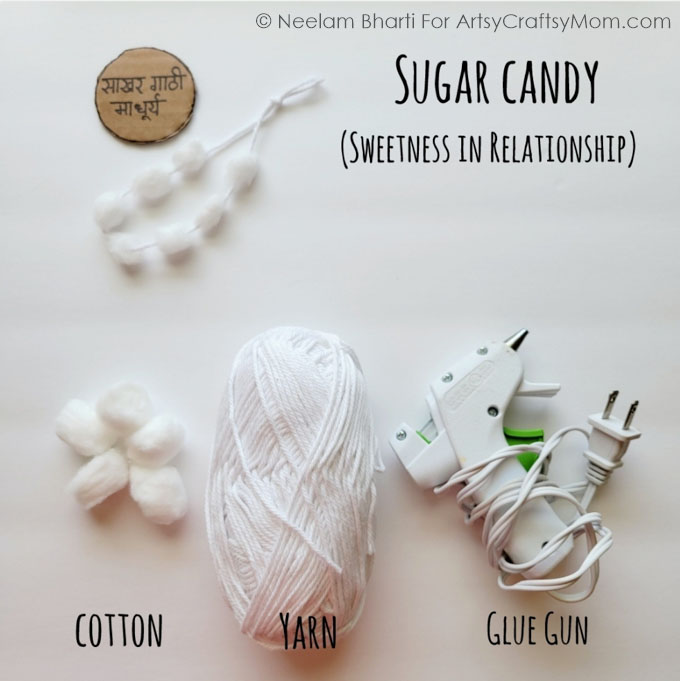
9. Time to make our mango leaves! Take the green paper and fold it in half. Using a pencil, draw the outline of mango leaves so that they start from the fold. Cut them out.

10. You now have pairs of mango leaves. Use a green color pencil to draw veins on the leaves.

11. Separate the leaves and keep them aside with the neem leaves and acrylic paints – we need them to finish our Gudi Padwa Craft!

12. We’re moving on to the main part of our mini Gudi Padwa Craft! If you can find a bamboo stick, great! If not, you can use a brand new pencil that hasn’t been sharpened yet.
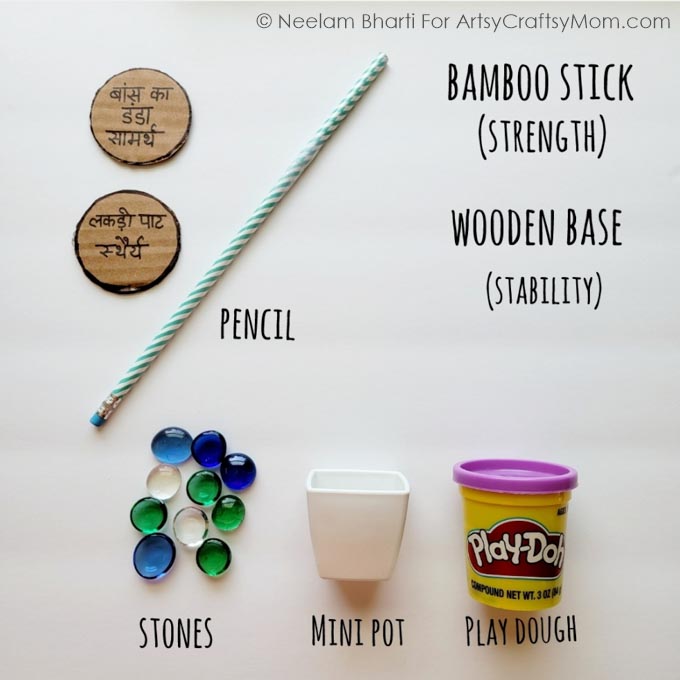
13. Let’s get our base ready first. Fill a small pot with something heavy, like stones or pebbles so it stays stable and doesn’t topple over later.

14. Insert the pencil into the pot, so that the non-eraser end of it is visible at the top. Seal the pencil in place using playdough. Make sure the pencil is not upright and is at a slight angle to the base.

15. It’s time for the final assembly! Place the piece of silk fabric on the upper end of the pencil. Arrange the red flower garland and the sugar candy garland on top of this fabric and secure everything in place with yarn. Insert the mango paper leaves and the artificial neem leaves into the yarn.
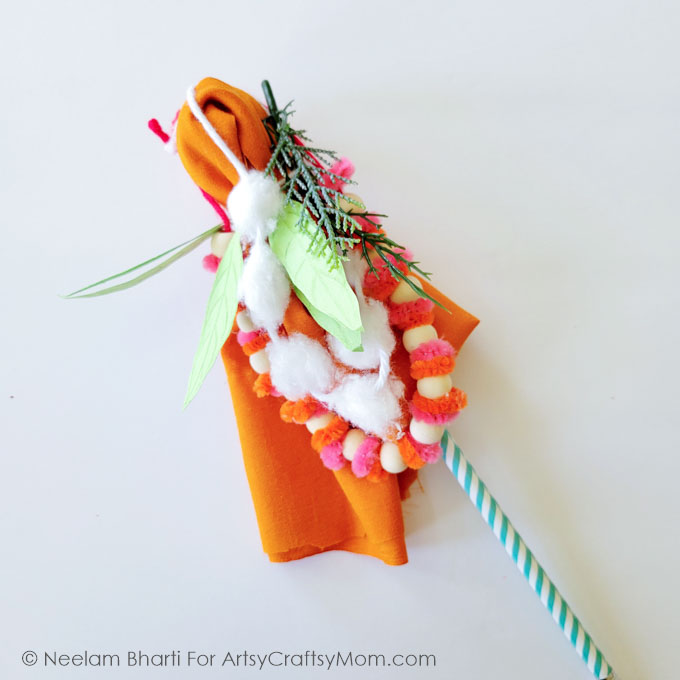
16. Place the miniature copper pot on top of the entire arrangement. Tie some red yarn around the mouth of the pot. use red acrylic paint to draw a swastika sign on the pot belly.
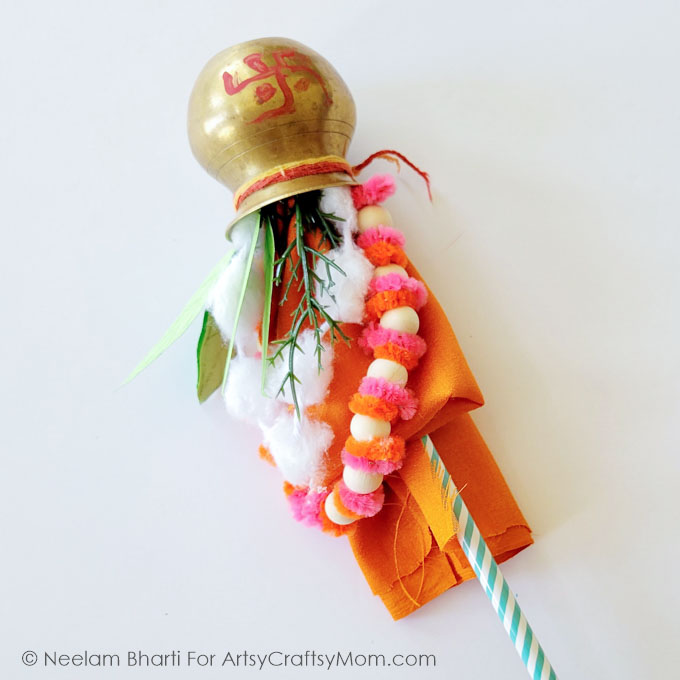
17. That’s it – your cute little Gudi Padwa Craft is 100% ready!

What is the scientific reason behind this ritual?
Just like every Indian festival, each element of the “Gudi” too has its own hidden scientific reasons, which are great to learn about as you make this Gudi Padwa Craft for Kids.
At the outset, an inverted pot is placed on the top and hoisted the night before. This is done so that the sun’s rays hit the pot first thing in the morning, and thus bring positive energy into the household. The pot is later used by the family members to drink water, and we all know the immense benefits of drinking water from a copper pot.
It also marks the end of the harvest season and starts a new crop season. The cloth (traditionally green in color) represents the earth and that the new harvest season will bring an abundant supply of grains and prosperity to the household. Being a new piece of cloth, it emits freshness and positivity.
The mango leaves absorb carbon dioxide and release oxygen thus cleaning the surrounding atmosphere. Neem leaves release maximum oxygen and also have anti-bacterial properties. This festival time, all family members and friends gather under one roof. So these leaves are used to create a maximum circulation of fresh air, maintain the optimal cooling room temperature and lastly purify the atmosphere from bacteria.
Sweet candy or shakar gaathi is a traditional sweet made from sugar and jaggery. Along with decorating the ‘gudi’, it is also eaten and has many health benefits. As for hoisting the “Gudi” outside the house, it is because it represents victory, and a victory flag is always held high!




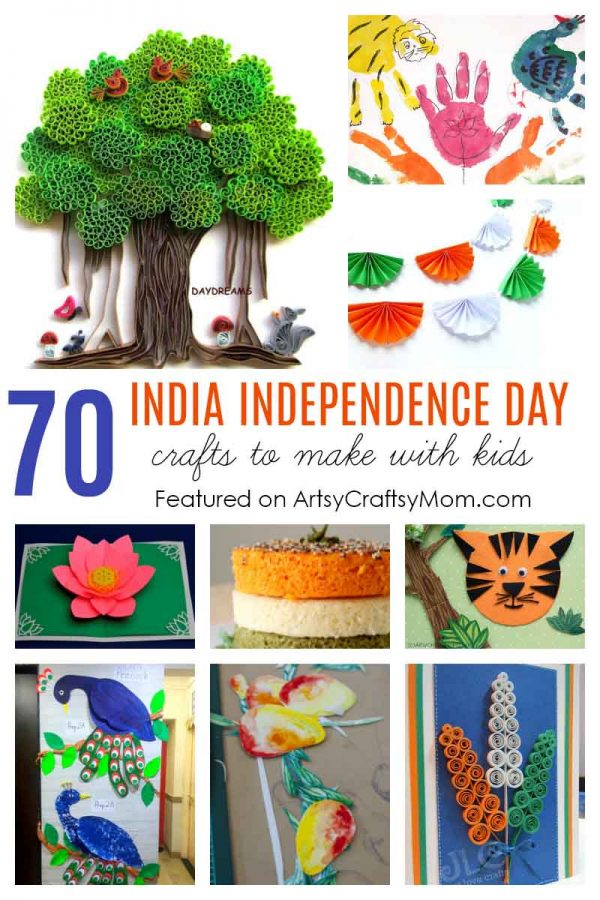








Responses